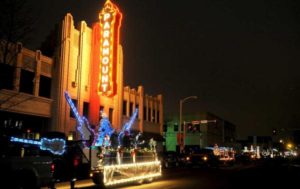Maybe I’m easily amazed.
Whatever.
My amazement is focused on what I have perceived to be a remarkable about-face at Amarillo City Hall. It involves the city’s focus on its downtown business and entertainment district. It has gone from a hands-off public policy to a definite hands-on approach.
I am utterly convinced the entire city will reap the benefit.
My wife and I arrived in Amarillo in early 1995 to start a new life — and to continue a life we started when we arrived in Texas 11 years earlier.
We saw a downtown district that was, to put it charitably, in a state of suspended animation. Downtown was in shabby condition. In addition to the Barfield Building and Herring Hotel — two significant structures that have been rotting ever since — the city had the vacant Santa Fe Building with which to contend.
Then the light bulb flickered on at the Potter County Courthouse. County Judge Arthur Ware finagled a deal to purchase the Santa Fe Building for $400,000. He then secured a state historic preservation grant to pay for a renovation of the magnificent 12-story structure. The project was completed — and the county moved some of its offices into the Santa Fe Building.
That might be considered the start of downtown Amarillo’s revival.
City Hall’s outlook, though, remained standoffish. Mayors Kel Seliger and Trent Sisemore seemed uninterested in getting involved directly with downtown revival. They preferred to let private business take the lead. The city might lend support — if it felt a project merited it.
Little happened over nearly a decade.
The pace has accelerated tremendously in the past decade. How did it come about? I believe it has been the result of a more activist City Hall approach.
The city launched a Strategic Action Plan, which produced a vision for the downtown district. It created Downtown Amarillo Inc. Center City became even more of a player. The city created the Tax Increment Reinvestment Zone. The Amarillo Economic Development Corp. invested sale tax funds to help some of these projects along.
Meanwhile, private businesses — apparently sensing the energy coming from City Hall — began a series of tangible improvement projects. New bank branches went up. A convenience store was built. The old Fisk Building was turned into a business hotel.
The momentum was building.
Then came the Embassy Suites hotel project. Plans took root to build a parking garage. And, oh yes, we have that multipurpose event venue/ballpark.
Along the way, some folks started expressing anger. They didn’t like the way the city was proceeding with some of these projects. They alleged “secrecy,” which I believe was a dubious accusation.
Sure, we had some serious misfires. Wallace Bajjali — the master development firm hired to oversee downtown’s resurrection — went kaput overnight. That, too, fueled the anger. Well, WB is long gone.
But the movement is continuing.
The City Council has gone through a serious makeover. There have been some more hiccups, mostly created by tensions among some of the council members.
Is all this amazing? Yes it is.
I do not want the city to turn away from its new course.
The city is going to ask voters to approve more than $300 million in infrastructure improvements, just as it asked voters to approve a referendum to build that MPEV downtown.
There are times when local government can step in — and step up — when it perceives a need.
Amarillo saw the need to boost its downtown district. Believe this: When this project is done — as every U.S. community that has taken this kind of proactive approach has learned — the entire city will reap the reward.
